
 | |
| Volume 4, Number 6 | November/December 1998 |
Two issues ago I introduced the "central conundrum" of pre-Flood Biblical chronology.[1]
The conundrum is the apparent existence of mankind, according to secular scholarship, many thousands of years before the creation date of Adam determined from Biblical chronology.
Last issue I enumerated nine conceptually possible solutions to this conundrum.[2]
{The Biblical chronological data leading to the creation of Adam are false (i.e., fabricated).}
{The secular chronological data leading to a great antiquity for mankind are false (i.e., fabricated).}
{The Biblical history which teaches that Adam was the first man to be created is mythological or otherwise fabricated.}
{The modern secular teaching that mankind existed in remote antiquity is a hoax or fabrication.}
{We have misunderstood the Biblical history of the creation of Adam; the Bible does not really teach that Adam was the first man ever to be created.}
{The archaeologists have misunderstood the history of mankind; archaeology does not really show the existence of humans before Adam.}
{We have made some mistake in the computation of the Biblical date of the creation of Adam (i.e., the basic Biblical chronological data are valid, but they have been misunderstood).}
{The secular chronologists have made some mistake in their computation of the antiquity of man (i.e., the basic secular chronological data are valid, but they have been misunderstood).}
{The Biblical and secular evidences must both be accepted as legitimate; the truth lies in a proper synthesis of the two.}
Last issue I discussed the first seven of these and showed that they each failed to present an adequate resolution of the central conundrum. This leaves two possibilities, the eighth and the ninth, to be explored.
This issue it is the eighth possible solution which is the focus of our attention. We are inquiring into the reliability of the secular dating of the antiquity of mankind. We are not questioning the validity of the basic physical data used in this dating process. The idea that the basic physical data are somehow fabricated has been discussed previously as the second possible solution of my enumeration. This idea has already been set aside as false. Thus, I take as a starting point for the present study that the measurements of the radiocarbon content of ancient human artifacts upon which the secular dating is based are good, valid, physical measurements, so that we would find the same radiocarbon concentrations ourselves were we to make the measurements on these ancient samples. The concern in the present study is not with the measured concentration of radiocarbon in the samples, but rather with the interpretation of those concentrations in terms of elapsed calendar years. Doesn't the process of converting a measured radiocarbon concentration to a calendar date involve certain assumptions? What guarantee is there that these assumptions are valid?
Notice that the discussion has already focused on radiocarbon dating, to the exclusion of all other dating methods. This is as it should be. The context of the present discussion is the putative existence of mankind prior to 5176±26 B.C., the creation date of Adam found from Biblical chronology.[3] We are trying to resolve whether absolute secular dates for human artifacts prior to 5176±26 B.C. are legitimate. Since there are no secular written records extending that far back into the past, the only way to determine the absolute date of an artifact at such ancient times is radiocarbon dating. So it is radiocarbon dating—and not potassium-argon dating, or rubidium-strontium dating, or any other dating method—which is of exclusive interest to the present discussion. Only radiocarbon dating functions in actual practice to furnish reasonably precise absolute dates to the secular archaeologists in the time period of interest to this investigation.
It is important to notice, however, that it is not the whole of radiocarbon dating which is of immediate concern to us here. The putative range of radiocarbon dating is roughly 50,000 years. But in this study we do not need to concern ourselves, at least initially, with the question of the reliability of radiocarbon dates 50,000 years ago. Recall that sound research strategy dictates that we focus on the most recent point of tension between sacred and secular chronologies.[4] This point is now at the creation of Adam, 5176±26 B.C., or roughly 7200 years ago, not 50,000 years ago. Thus, our strategy must be to find a set of radiocarbon determinations for human-related archaeological samples in the millennia immediately prior to the creation date of Adam, and investigate those radiocarbon dates critically to see if they are truly reliable. If they are not reliable—if we are able to show that some faulty assumptions have been made so that those human-related samples should really be dated after, rather than before the creation of Adam—then will be the time to critically examine yet older radiocarbon dates. If, on the other hand, they are found to be reliable, then the apparent existence of mankind prior to the creation of Adam is affirmed and there is no reason to pursue the reliability of radiocarbon any further back in time—at least as far as the present investigation is concerned.
There are any number of suitable radiocarbon determinations which might be chosen for critical examination in the present context. I suggest, however, that we focus our attention on radiocarbon measurements from Jericho. My main reason for this suggestion is that Jericho is already somewhat familiar to most of us. Thus, it does not entail quite the difficult learning curve of other less familiar archaeological sites. Also, Jericho ties in very neatly with Biblical chronology at the time of the Conquest.[5] This provides us with a well established Biblical chronology reference point, which is convenient for checking the results of radiocarbon at Jericho at least that far back in time.
Jericho is a conspicuous mound located about 6 miles (10 km) north of the Dead Sea. The mound rises on average about 50 feet (17 m) above the surrounding plain. The mound is made up of the debris of thousands of years of human occupation at the site. It is like a huge layer cake, with each layer representing one chapter in the history of Jericho. The oldest layer is at the bottom, with successively more recent layers above. This results from generation after generation of occupants leveling older remains and building anew on top of the compacted rubble of the past.
Figure 1 is a schematic diagram of the dwelling styles found within the layer-cake strata at Jericho. Only the order of the strata are represented in the figure, not their relative thicknesses. We owe our ability to construct such a diagram to the work of the British archaeologist Kathleen Kenyon. Between 1952 and 1958 she labored with a substantial crew, digging several very deep trenches into the mound of Jericho to expose its ancient buried history.[6]
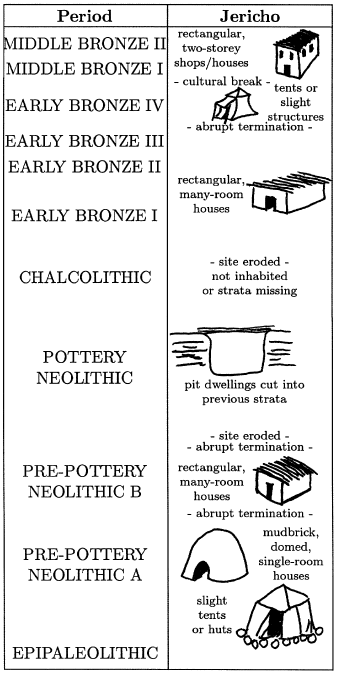 |
The right column illustrates only a small portion of what Kenyon found by digging through the mound at Jericho. I have chosen to illustrate the style of domestic architecture which she discovered to be characteristic of the various layers, but the remains of houses are not all that Kenyon and other archaeologists found at Jericho, by any means. They also found stone tools, art-work, burials, animal bones, pottery fragments, seeds and other plant remains, metals, and much more. All of these artifacts show pronounced differences from level to level within the mound, revealing the markedly different ways of life of the occupants of Jericho from period to period.
Before we proceed I need to point out that my illustrations of the dwelling styles found at Jericho are very rough sketches of the basic forms only—they are not technically precise at all. Note also that Kenyon did not find instances of these dwellings all nicely preserved in the various strata in every case. Rather it was generally the case that only the foundation remained intact, and she had to deduce the form of the rest of the building from the rubble of the collapsed walls and roof which covered it.
But the major point to notice is that clearly-identifiable remains of domestic dwellings and many other types of artifacts are found—the mound is not just a hodgepodge of randomly scattered rocks and dirt by any means—and the characteristic styles of these dwellings and other artifacts vary markedly from one level to the next within the mound.
Distinct material differences in the artifacts recovered from various levels are not only found at Jericho but, indeed, at all ancient mounds throughout the land of Israel. Meanwhile, similarities in domestic dwelling styles, pottery styles, tool styles, and so forth, can be traced from mound to mound throughout Palestine in the same succession found at Jericho.
The patterns of artifact styles are, in fact, persistent and widespread. Their obvious stratigraphical separation clearly assigns them to different, successive periods of time. A set of names for these successive periods, such as "Chalcolithic" and "Early Bronze", has grown up over the decades of archaeological research in Palestine. These are shown in the left column of the figure, opposite the illustration of the dwelling style found at Jericho corresponding to that period.
Now I must briefly clarify the significance of these period names. They were originally coined on the basis of evolutionary notions of the development of man and his tool assemblages. While mankind's technological abilities have increased throughout history, just as they continue to do today, the simplistic evolutionary scheme imagined by the inventors of these period names has not been supported by subsequent archaeological research. For example, "Neolithic" ('neo' = new, 'lithic' = 'stone') originally implied a period during which mankind had passed from the use of crude stone tools into the production of more technologically advanced stone tools. Today its meaning has come to imply a settled agricultural lifestyle, rather than any sweeping generalizations regarding the technology of stone tool manufacture. These period names are retained by archaeology today because of historical precedence, not because of any intrinsic descriptive value or literal significance, and they should not be interpreted literally by the reader.
The figure shows the archaeological strata found at Jericho from bedrock up until Middle Bronze II (MBII). There are yet more recent layers on top of the MBII stratum, but these are of no interest in the present context.
Figure 1 shows only a relative progression of domestic dwelling styles at Jericho. It does not tell us when, in calendar years, these various styles were in use there. If this relative progression was all the archaeologists had to say about Jericho there would be no problem—no central conundrum—at Jericho at least. We could imagine that the slight tents or huts at the bottom of the mound were constructed by some of Adam's great-grandchildren, for example, who had migrated to Palestine from Mesopotamia.
But the archaeologists don't stop with Figure 1. Archaeologists quite routinely attempt to couple their archaeological data to chronological data (and please note that the two are not the same thing at all) in an effort to produce an accurate reconstruction of the past. It is this process of adding absolute time to Figure 1 which gives rise to our central conundrum.
The youngest (highest up) strata shown in Figure 1 are in historical times. They can be assigned absolute (calendar) dates on the basis of written sources. I will do this below.
It is the older strata—especially the Neolithic strata—which are really of interest to the present study. No written records are ever found in these early strata—one naturally infers that writing was unknown to these people—so that it is impossible to date them using contemporaneous historical texts. The only way reasonably precise absolute dates can be obtained for these strata, as I have mentioned above, is through application of the radiocarbon dating method.
James Weinstein has compiled a convenient and pretty much exhaustive list of radiocarbon dates from archaeological sites in southern Palestine.[7] My procedure in this section is simply to display every radiocarbon date listed by Weinstein for Jericho from the Pre-Pottery Neolithic A (Weinstein calls this the Early Neolithic I) through the Early Bronze IV period. It is the Neolithic radiocarbon dates which are of real interest to the present study, but I have included the more recent radiocarbon dates as well, up through the Early Bronze, so we can see how well radiocarbon does in these more recent, historically dated periods.
Now I must make you aware of a slight deviation from my just-stated procedure. Weinstein lists sixty radiocarbon dates from Jericho in the period of interest. The oldest three of these dates, from the Pre-Pottery Neolithic A period, encounter a technical problem which necessarily excludes them from our study.
Radiocarbon dates are routinely calibrated today whenever one wishes to talk in terms of absolute calendar years, as is the case in the present investigation. (I plan to discuss more about the calibration procedure next issue.) The problem with these three oldest dates is that they extend beyond the range of the (computerized) calibration table.[8] This means that absolute calendar dates cannot be specified for them at present. It is necessary to exclude them from this study for this reason. This exclusion does not impact the outcome of the present investigation in any way. It merely reduces our sample of dates from sixty to fifty-seven.
I must also point out, in passing, that we are very privileged to have access to this sort of data today. The cost of a single radiocarbon determination on a sample today is roughly $300. Thus, it is our privilege to work, free of charge, with a set of data which we must value, in modern terms, in excess of $17,000. And this does not take into account the prodigious expense of obtaining the samples from deep within the mound of ancient Jericho, the result of several years of archaeological excavation.
Fifty-six of the fifty-seven radiocarbon dates of interest are from charcoal samples. Since radiocarbon measures when a tree grew, not when its wood was used by humans, it is possible to get older dates than we should for a given strata in some instances. But we would expect this inaccuracy to amount to no more than several decades in most instances, and we would expect it to exceed a century only very rarely. Because wood rots, dead trees are not likely to sit around for several hundred years before being used by humans in some construction project, or as fuel for their fires. So this source of dating error is not expected to be a problem for the present purpose. Uncertainties of a few decades or even a few centuries for radiocarbon dates in the Neolithic are of little concern to our present purpose, being much smaller than the problem of the thousands of years before Adam which we are endeavoring to resolve.
Figure 2 shows the graphical output from the calibration computer program for the Pre-Pottery Neolithic A radiocarbon dates. Seventeen of the fifty-seven samples fall in this group. Each horizontal bar in the figure represents one of these seventeen samples. Each sample is given a unique label, shown at the right side of the graph. The letters at the front of a label identify the radiocarbon laboratory which made the radiocarbon measurement on that sample. The numbers following the lab identifier are sample numbers, used by the laboratory to distinguish one sample from the next.
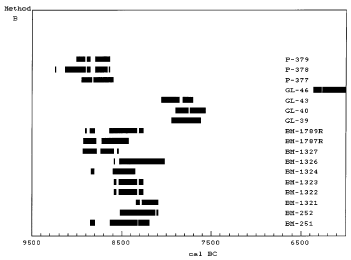 |
The broken horizontal black bars indicate the intervals in which the true calendar date of the sample is most likely to lie (i.e., when the original wood sample most likely grew). Radiocarbon does not furnish a single date for a sample, but rather it gives a probability distribution describing the relative probability the sample originates in a given time interval. The probability is roughly two-thirds that the true date of the sample falls somewhere in the black barred regions, and one-third that it falls outside those regions. As a general rule, the farther one goes away from the broken black bar on the time line, the more unlikely it is that the true date of the sample falls there.
Most of these dates group together on the time line, as they should if all of the samples originate from the same approximate time. However, sample GL-46 is suspiciously different (more than 1000 years) from all the others. This is the one sample of the fifty-seven which is not charcoal. In fact it is listed as "humic extract", which offers an immediate explanation of its relative youthfulness.
An ancient lump of charcoal is likely to become contaminated by modern living things before it is taken from the ground. For example, there may be rootlets from modern plants penetrating it. Or there may be bacteria or fungi growing on it.
If the whole lump of charcoal with all these modern contaminants is dated, one will get a date part way between the age of the charcoal and modern times. Said another way, the modern contaminants will make the radiocarbon age of the sample come out too young.
To get the true date of the charcoal, it is important to get rid of all contaminants before the sample is dated. One could physically remove rootlets using a microscope and a tweezers, for example. And one could remove fungi and bacteria, which reside on the surface of the sample, by dissolving away the surface of the charcoal with a suitable chemical.
Such procedures are called sample "pretreatment". They are routine in all radiocarbon dating laboratories today.
The "humic extract", sample GL-46, does not represent an archaeological sample at all. Rather, it is the part of the sample with all the contaminants which was dissolved during pretreatment. This sample would only have been "dated" by the radiocarbon laboratory to check their pretreatment procedure. One could imagine dissolving an ancient lump of charcoal in stages, and "dating" the dissolved portion of the sample at each stage. The first stage would contain the most contamination, and would give the youngest "age" as a result. Subsequent stages would contain less and less contamination, as more and more of the surface of the sample was dissolved away. The dates for these subsequent dissolved portions of the sample would become progressively older, until, eventually, all of the modern contamination was gone. After that each new stage of dissolved sample would yield the same, true date.
This is the sort of experiment a radiocarbon lab would run in the early days of its operation to determine how much pretreatment was necessary to remove all contamination from a sample. GL-46 appears to be only the forty-sixth sample to have been processed by the GL laboratory. Thus, this is very likely the explanation of GL-46. It is not a proper date of an archaeological sample at all, and, strictly speaking, should never have been included in Weinstein's archaeological list. I will eliminate it from subsequent discussion.
Once lab identifiers and sample pretreatment are understood, a red flag goes up with three other samples in Figure 2. We notice immediately that the other three GL samples all date significantly younger than the samples which were dated by the other two labs. At this stage we cannot tell whether this is because the Pre-Pottery Neolithic A period lasted this late in time, and the GL lab just happened to get the youngest samples from this period, or whether the GL lab, at this obviously early point in its history, had not yet perfected its pretreatment technique. To resolve this we need to go to the Pre-Pottery Neolithic B radiocarbon samples. These are shown in Figure 3.
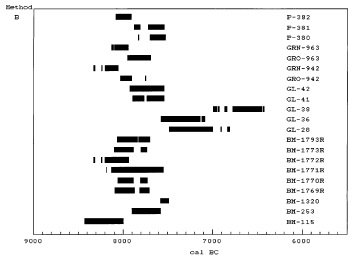 |
A comparison of Figures 2 and 3 shows that the Pre-Pottery Neolithic B starts (and hence the Pre-Pottery Neolithic A is over) before the GL dates of Figure 2 on the Pre-Pottery Neolithic A samples. Figure 3 also shows three of five GL samples significantly younger than the samples from the other labs once again. These GL measurements seem to show inaccuracies due to a lack of refinement in experimental technique. This is not too surprising since they were made very early on in the history of radiocarbon dating.
In quantitative terms the GL samples' inaccuracies are not all that large. They are, in fact, less than 10%. That is, the difference between the GL measurements and those of the other labs is less than 1000 years, out of a total measured time (from the present) of more than 10,000 years.
Inaccuracies on this order are common in science when one first sets out to make physical measurements of any sort. There are many things which can go wrong when one attempts to make physical measurements in the real world (because God's great creation is, in fact, not at all a simple affair) and one generally only learns about all the things that can go wrong by a painful process of them all going wrong. So these GL inaccuracies are understandable and even excusable. They cannot reasonably be taken as evidence of some general inaccuracy inherent in the radiocarbon dating method.
It is normal in science to eliminate from further consideration measurements which one knows are inaccurate. It is reasonable to do this with these inaccurate GL measurements at this stage. Since the reason for the inaccuracies in this case appears to be lack of experience on the part of the GL lab, it seems best, in order to avoid subjective bias, to simply exclude all GL dates from our final data set, whether they are in agreement with the results of other labs or not. There are a total of ten GL dates in the original set of fifty-seven, so this shrinks the total number of usable dates down to forty-seven. These forty-seven are still quite adequate for the present purpose, so I will follow this simple procedure in my final assignment of absolute dates to the Neolithic strata at Jericho.
Now notice that many of the BM samples in both Figures 2 and 3 have the letter R appended to the sample number. The R in this case stands for "revised". The radiocarbon dates of these samples were initially measured and published in the 1980s. After publication the BM laboratory discovered that the dates on these and several hundred other samples processed during the same interval of time by their lab were incorrect. This resulted from some systematic errors in the calibration of the radiocarbon counters during the period when these measurements were being made. The BM lab found it necessary to revise the dates on these samples by several hundred years to correct for these systematic errors. Sample numbers with the R appended are the new, revised, published dates.
Weinstein's list, which was published in 1984, contains the original, uncorrected dates. I have used the revised dates, which were only published in 1990, rather than the original dates listed by Weinstein.[9]
All of these inaccuracies and blunders certainly do not enhance radiocarbon's image. But they do belie the notion that radiocarbon labs are all in cahoots to scam the general public with a bunch of fabricated dates. They also falsify the idea that only selected dates, in agreement with some predetermined time scale, ever get published. And they certainly illustrate that radiocarbon is not a magic wand—a thing you wave over an archaeological sample and out pops the date of interest. Radiocarbon dating is a normal, intricate scientific procedure, carried out by normal, fallible human beings. And despite the best efforts of scientists and technicians, not all space shuttles return safely to the ground.
But we must not be distracted from our present purpose by these human errors. We are not interested, in the present investigation, in the question of whether radiocarbon scientists and technicians are infallible. They clearly aren't, but this fact is neither very surprising nor very helpful. It is not random human blunder, but rather systematic methodological error which interests us here. The fact that some of the dates in Figures 2 and 3 can be shown to entail random human errors of one sort or another, introducing inaccuracies as large even as 1000 years in some cases, only teaches us that we must not trust lone radiocarbon dates. Rather, we must demand evidence of reproducibility of results, preferably by several different labs. But this rule is quite generally applicable to scientific measurements of all sorts, and it does not add anything of interest to the present study. What we wish to learn at present is whether all of the radiocarbon dates in these two figures are somehow systematically too old by at least 3000 years.
There are, unfortunately, no radiocarbon dates yet from Jericho for the Pottery Neolithic or the Chalcolithic. No samples have been submitted for radiocarbon dating from the Pottery Neolithic strata, and it is not clear whether Chalcolithic strata exist at Jericho—the site may have been unoccupied during that period.
The next set of dates at Jericho comes from the Early Bronze I period. These are shown in Figure 4. There are only five dates for this period so far, and one of them is clearly an outlier. This is a GL determination once again, further confirming our suspicions regarding these early GL dates.
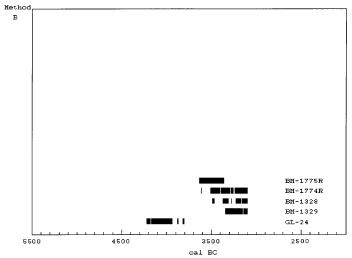 |
The next set is from Early Bronze III (Figure 5). There are twelve determinations in this set.
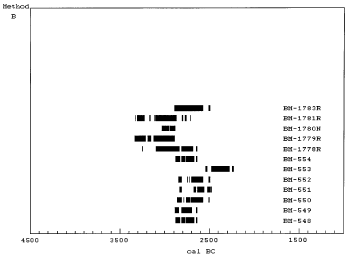 |
The final set is just two dates from Early Bronze IV (Figure 6).
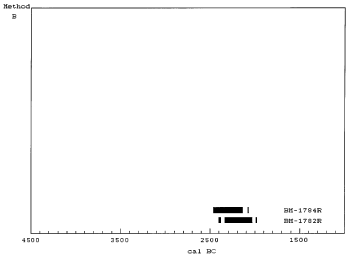 |
These radiocarbon determinations purport to provide rough absolute dates for the stratigraphical units from which they were taken. They aspire to inform us when, in absolute time, these stratigraphical units were being formed. They suggest that Kenyon's stratigraphy of Jericho be assigned absolute dates as shown in Figure 7.
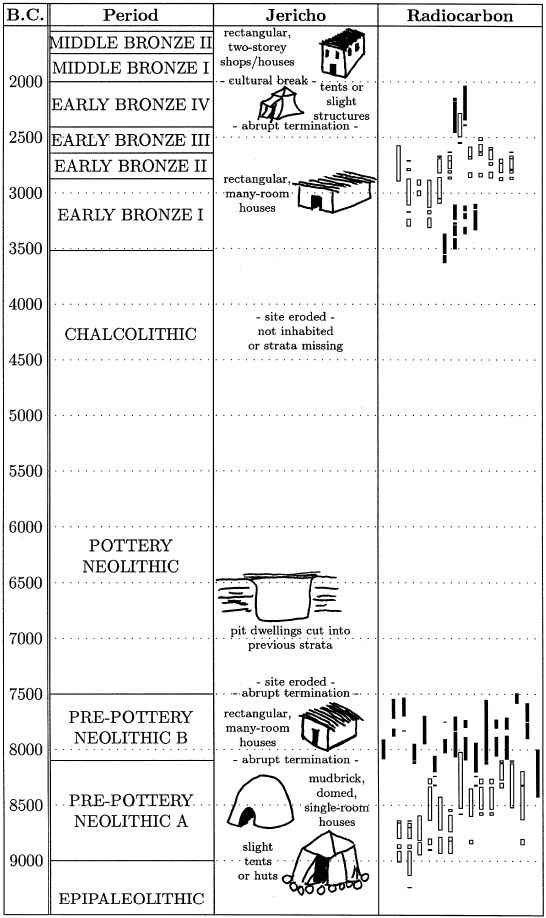 |
Before proceeding notice that this time chart covers eight millennia. Thus, the time scale is very compressed compared to other time charts which have previously appeared in this publication. From the perspective of Biblical chronology, this is a very panoramic view.
I have ventured period boundaries for the Pre-Pottery Neolithic on the basis of the radiocarbon results from Jericho shown in the "Radiocarbon" column.[10] (Note that all GL samples have been excluded from this column as discussed above.) The boundary between Pre-Pottery Neolithic A and Pre-Pottery Neolithic B is probably secure to within a century since it is bracketed by radiocarbon dates both above and below. The other two Pre-Pottery Neolithic boundaries are not nearly as secure, however, since they each have radiocarbon dates on one side only. Future radiocarbon determinations at Jericho may require that these boundaries be substantially adjusted.
I have not attempted to draw a boundary between the Chalcolithic and the Pottery Neolithic because we have no radiocarbon data from Jericho for these intervals. However, it is important to realize that radiocarbon dates do exist from other archaeological sites for the Pottery Neolithic and Chalcolithic periods in Palestine. Weinstein lists thirty-three radiocarbon dates for these two periods from other sites.
I have not used radiocarbon to establish any of the Bronze Age boundaries. Rather, I have used what we already know about these periods from my previous chronological work.[11] The Bronze Age places us within the historical period, and historical documents giving lengths of the reigns of kings and similar chronological information are preferred to radiocarbon because the dating uncertainty arising from them is generally much smaller than it is for radiocarbon. Note that there are NO historical documents for any of the Neolithic, so radiocarbon is the only way period boundaries within the Neolithic can be determined.
In regard to our primary question this issue—the reliability of radiocarbon—note, first of all, that the radiocarbon determinations from Jericho in Figure 7 leave the stratigraphy in its proper order. The lower strata are indeed the oldest, according to radiocarbon, and the upper strata the youngest. This immediately tells us that radiocarbon can be trusted to provide reliable relative dates, at least, regardless of what one may eventually conclude about the trustworthiness of its absolute dates.
Notice also that there is nothing capricious or erratic about the radiocarbon dates in this figure. There is some scatter, but it is well within what one should expect from the shown uncertainties in the individual measurements. The results are systematic, rather than chaotic, with radiocarbon dates from a given stratum grouped together, rather than spread helter-skelter here and there all over the time chart. The overall behavior of the data is really quite ordinary, as far as physical measurements go. This tells us that radiocarbon is measuring something which is really there, not something imaginary.
Notice, finally, that the radiocarbon dates from the Early Bronze IV stratum fall within the historically delineated Early Bronze IV period of time. The four radiocarbon dates from the Early Bronze I stratum are similarly all in harmony with the historically delineated boundaries of that period. This is evidence that radiocarbon does merit some degree of trust, not just for relative but also for absolute dates, at least as far back as 3500 B.C.
The twelve radiocarbon dates from the Early Bronze III (EBIII) stratum seem at first to undermine this conclusion somewhat. Only seven of them overlap the Early Bronze III period shown in the time chart. The remaining five seem to demand an Early Bronze II (EBII) or even late Early Bronze I (EBI) setting.
Recall, however, that there is really no archaeological distinction between EBII and EBIII.[12] Indeed, it appears that EBII and EBIII are contemporaneous—rather than separated as shown in the time chart—with EBII pottery and culture being typical of southern Palestine, and EBIII pottery and culture typical of the rest of Palestine, as Cohen has previously argued.[13] [14]
That being the case, we actually expect there to be no EBII period evident at Jericho—EBIII should follow directly after EBI there. This, in fact, is the principal thing these twelve radiocarbon dates from the EBIII stratum at Jericho actually show. Thus, rather than undermining confidence in radiocarbon's absolute dating ability, these twelve dates reinforce our confidence in it—at least back to 3500 B.C.
But now let us zero in on our central conundrum. To help with this I have added a "Bible" column to the time chart (Figure 8). I have placed three key Biblical events at their appropriate times in the chart according to Biblical chronology.[15] The conundrum is immediately apparent—the Neolithic and earlier strata at Jericho, with their plethora of evidence of human activity, predate the creation of Adam in this time chart.
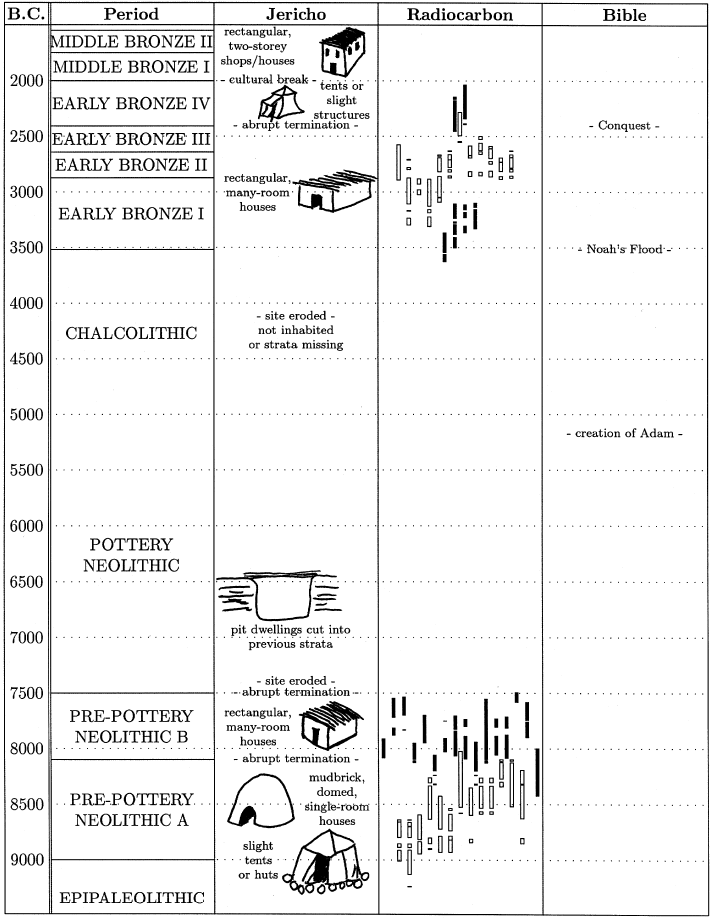 |
This happens solely because of the radiocarbon dates on the charcoal samples from the Neolithic strata. Are these radiocarbon dates accurate? Can they be trusted?
In relation to these questions note, first of all, that no attack on radiocarbon which calls its assumptions into question in a general way can be accepted. In addition to the evidences in favor of the general validity of radiocarbon back to 3500 B.C. mentioned above, Biblical chronology affords us two checks of the radiocarbon method back to that same time, and these yield the same conclusion in favor of radiocarbon.
The first check is the Conquest. We now know that EBI through EBIII is the civilization of the Canaanites.[16] We know that EBIV is the civilization of the early Israelites whose history is chronicled in the book of Judges.[17] We know, from the Bible, that Canaanite civilization was terminated, and Israelite civilization in Palestine initiated, by the Conquest. Finally, we know from Biblical chronology that the Conquest happened 2407±13 B.C.[18] Thus, if radiocarbon dating is reliable, then radiocarbon dates on artifacts from the EBI through EBIII (Canaanite) strata should fall before 2407±13 B.C., and radiocarbon dates on artifacts from the EBIV (Israelite) stratum should fall after 2407±13 B.C. Figure 8 shows that the requirements of this Biblical check on radiocarbon are satisfied. Thus we find that radiocarbon agrees with Biblical chronology back to the Conquest.
The second Biblical check is Noah's Flood. We now know that the Flood terminated Chalcolithic civilization in Palestine, and that the Early Bronze civilization sprang up there through the spread of Noah's descendants following the Flood.[19] Thus, if radiocarbon dating is reliable, then radiocarbon dates from Early Bronze Age artifacts should date after (more recent than) the Flood. Figure 8 shows that this requirement of this Biblical check on radiocarbon is satisfied for eighteen out of eighteen Early Bronze radiocarbon samples. Thus we find that radiocarbon checks with Biblical chronology right back to Noah's Flood.
Thus, the idea that radiocarbon is quite generally faulty because of some mistaken, basic assumptions simply cannot be accepted. If there is anything wrong with radiocarbon dating, we see immediately that the problem can only enter in for dates before the Flood, i.e., prior to about 3500 B.C. The evidence is very plain that radiocarbon is trustworthy after the Flood. The only question remaining is, "Is radiocarbon trustworthy before the Flood?"
But this question cannot be properly treated in any brief space, so I hope to deal with it at length next issue. ◇
Dear Dr. Aardsma,
Last night I attended a seminar by an amateur archaeologist, Ron Wyatt. He presented conclusive evidence of the precise location of the Red Sea crossing by the discovery of 4, 6, and 8 spoked chariot wheels at the bottom of the Gulf of Aqaba. The wheels belong to the 18th Dynasty of Egypt, which confirms a 1446 B.C. Exodus. This [date for the wheels] was confirmed by the Egyptian Department of antiquities.
Mr. Wyatt believes as you do that Djozer was the pharaoh Joseph served and that Imhotep is Joseph and also the seven year famine. I was going to ask him a pointed question at the end of the seminar as to how he could identify Joseph as Imhotep when Djozer and Imhotep supposedly lived during the 2700th year B.C. At the end of the seminar, before question time, he proceeded to answer my question without me having to ask it. He explained that modern scholarship has "created" an entire dynastic period in ancient Egypt which has created an error in chronology by 1000 years. He is referring of course to the Old Kingdom. He explained that Djozer and Imhotep lived around the time of the Middle Kingdom because pharaohs went by many different names by the districts they ruled.
If he is right, which he seems to be, he clearly vindicates the accuracy of the 480 years of 1 Kings 6:1. What do you think?
George Karakasidis
Australia
P.S. I've enclosed a sample paper of his findings.
Dear George,
Thank you for your letter and the copy of the International Discovery Times[20] summarizing Ron Wyatt's claims. Since all of my work in Biblical chronology is based on the claim that the 480 years found in 1 Kings 6:1 today was originally 1,480 years, Wyatt's claims certainly strike at the foundation of The Biblical Chronologist. If what he is claiming is backed by "conclusive evidence" as you have stated, then my work in Biblical chronology is obviously seriously mistaken. You are quite correct in bringing Mr. Wyatt's claims to my attention, and in requesting an explanation of me.
The critical question, of course, is whether Wyatt's claims are really backed by "conclusive evidence". In the following paragraphs I aspire to show that they aren't—that in actual fact the evidence is conclusive against them.
The hub of Wyatt's claims is the supposed discovery of the true Mt. Sinai, a mountain to the east of the Gulf of Aqaba, in modern Saudi Arabia, called Jabal al Lawz (Figure 9). According to Wyatt, the Israelites crossed the Gulf of Aqaba, about mid way along it, in their flight from Egypt on their way to Mt. Sinai. According to Wyatt this is the site of the famous "Red Sea" crossing which the Bible tells us about, where God parted the waters, the Israelites crossed safely, and Pharaoh and his army were drowned when they attempted to follow.
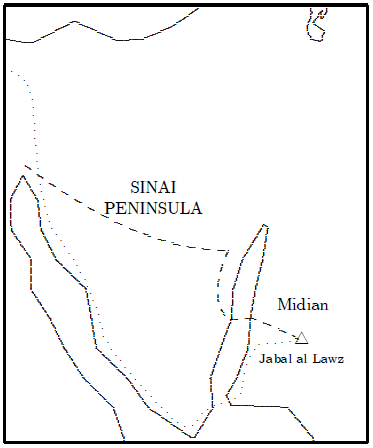 |
As "proof" of this crossing site Wyatt claims to have found wheels and other chariot debris, together with "human and horse remains" ( International Discovery Times, page 4), scattered across the floor of the Gulf of Aqaba at this location. Furthermore, he claims to have found memorial pillars, erected by King Solomon on either side of the crossing site, commemorating the Biblical Red Sea crossing at this point.
The chariot wheels provide the critical chronological link. According to Wyatt he found four, six, and eight-spoked wheels at the bottom of the Gulf of Aqaba, and, claims Wyatt, "according to numerous sources, it was only during the 18th Dynasty that four, six and eight spoked wheels were all used" ( International Discovery Times, page 4). Since the 18th Dynasty lasted from about 1550 B.C. to about 1300 B.C., this seems to place the date of the Red Sea crossing somewhere in that range. This, in turn, seems to confirm the "480 years" of 1 Kings 6:1, since when this number is taken at face value Biblical chronology yields a date of about 1450 B.C. for the Exodus.
This all looks very impressive, and I am sure it was very much so at the seminar, with color slides of chariot wheels and all, and Mr. Wyatt himself telling the story of his adventures. I can certainly understand how you would come away from the seminar with the feeling that you had seen "conclusive evidence". But this whole thing begins to unravel rather badly when subjected to a little cross examination.
For the purpose of my cross examination I will call upon three witnesses to testify below. These three are Larry Williams, radiocarbon, and the Bible.
Larry Williams is, in some sense, a follower of Wyatt. He has followed Wyatt to Jabal al Lawz, Wyatt's "true" Mt. Sinai. He is obviously a believer in this site, for he has gone to it twice—illegally, as did Wyatt before him—to explore and photograph it. (And he was caught, and thrown in jail by Saudi authorities—as was Wyatt before him—for his illegal activities. You can read all about it in Williams' book, The Mount Sinai Myth.[21])
Since Williams must obviously have been well-familiar with Wyatt's claims regarding Jabal al Lawz before he risked the potentially serious consequences of illegal entry into Saudi Arabia, it is reasonable to suppose he was also well-familiar with Wyatt's claims regarding the site of the Red Sea crossing—including the chariot wheels, "Solomon's" pillars, and all. The chronology of events seems also to confirm this supposition—Wyatt's discovery of his crossing site dates to 1978 ( International Discovery Times, page 4), a full decade before Williams first ventured into Saudi Arabia ( The Mount Sinai Myth, page 147).
So my question for Williams, now seated in the witness stand, is this, "You obviously agree with Wyatt's claim regarding Jabal al Lawz; what do you think of his Red Sea crossing site?"
Williams' answer is clearly portrayed in the map of the route of the Exodus which he draws. I show his proposed route of the Exodus in Figure 9. Notice that Williams places the Red Sea crossing at the mouth of the Gulf of Aqaba, not half way up that body of water. Apparently Williams, who we may conclude has had reason to take as careful an inside, close-up look into Wyatt's claims as any man might, flatly rejects Wyatt's Red Sea crossing site. Evidently he finds the chariot wheels, horse and human remains, and Solomon's pillars—Wyatt's "conclusive evidence"—not all that conclusive, because he proffers an entirely different crossing location.
Now if Williams, as close-up familiar with Wyatt's chariot wheel evidence as anybody is likely ever to be, rejects the claim that these are genuine artifacts from the Red Sea crossing, then we may suppose that there may be some good reasons not to accept Wyatt's claim in this regard, however hidden from our eyes those reasons may be. And in that case it follows immediately that the date of these alleged chariot wheels—18th Dynasty or whatever the truth may be—is irrelevant to the matter of the proper date of the Exodus.
My second "witness" is radiocarbon dating. You say Wyatt claims that the secular scholars have goofed up the historical chronology of Egypt, creating a fictitious dynastic period—that the Old Kingdom is basically synchronous with the Middle Kingdom rather than preceding it as the secular scholars claim. In this view the problem between secular and sacred chronologies is not that traditional Biblical chronology has accidentally dropped out a full millennium, as I claim, but rather that the secular scholars have added in most of an additional millennium to the chronology of Egypt.
It is easy to check this claim using radiocarbon. Radiocarbon dating is completely independent of the historical texts used by the secular scholars to construct the chronology of ancient Egypt. If the secular scholars have goofed in their historical dating by 1000 years, then one should find that Old Kingdom artifacts come out 1000 years younger than the scholars' expectations when dated using the radiocarbon method.
A very extensive radiocarbon dating program was carried out on Old Kingdom artifacts by Haas et al. over a decade ago.[22] Over seventy samples were dated in this study. In point of fact they found, not that the radiocarbon dates were 1000 years younger than the historical chronology, but that they were several hundred years older (Figure 10). While this is completely contrary to Wyatt's claim, it readily harmonizes with the predictions of Biblical chronology when allowance is made for 1000 years accidentally dropped from the text of 1 Kings 6:1, as I have previously shown.[23]
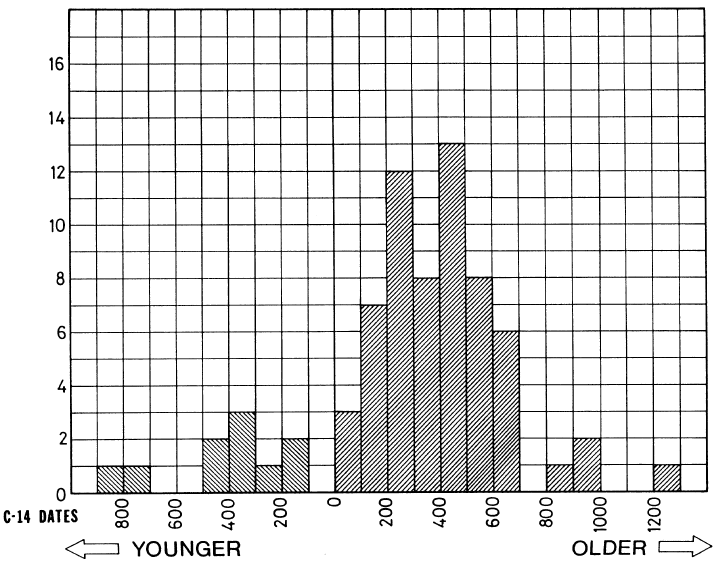 |
My third "witness" is the Bible. As I mentioned above, the hub of Wyatt's claim is that the true Mt. Sinai is located in Saudi Arabia. If Mt. Sinai is not located in Saudi Arabia, then there was no reason for Moses and the Israelites to cross the Gulf of Aqaba to get there. And in that case, whatever artifacts Wyatt may have found at the bottom of the Gulf of Aqaba clearly have nothing to do with the Exodus.
The difficulty for Wyatt at this point is that the Bible excludes the possibility of Mt. Sinai being in Saudi Arabia. I have explained this before, in relation to my critique of Larry Williams' book, so I will review only briefly here.[24]
The region to the east of the Gulf of Aqaba, where Jabal al Lawz is located, is recognized by scholars to correspond to the Biblical land of Midian. Wyatt labels the region as Midian in his graph in which he shows his proposed Exodus route ( International Discovery Times, page 4).
The Bible tells us that Moses' father-in-law, Jethro, lived in Midian (e.g., Exodus 3:1). After the Exodus, Jethro came to meet Moses at Sinai (Exodus 18:5). Following his visit the Bible informs us that Jethro "went his way into his own land". Thus, Jethro reentered Midian after leaving Mt. Sinai, and therefore we must conclude that the Bible places Mt. Sinai outside Midian's borders.
The Bible testifies that Jabal al Lawz is not Mt. Sinai. Thus, there is no apparent reason why the Israelites would ever have crossed the Gulf of Aqaba.
On the basis of the testimonies of Larry Williams, radiocarbon, and the Bible we may safely conclude that whatever Mr. Wyatt may have found at the bottom of the Gulf of Aqaba or on its shores has nothing to do with the Exodus or the Red Sea crossing.
So what are we to make of Mr. Wyatt's chariot wheels? It may seem to you that the slides you have seen and the story you have heard are conclusive evidence of real chariot wheels found by Mr. Wyatt at the bottom of the Gulf of Aqaba at his Red Sea crossing sight. I am skeptical, but let us not quibble about this. Let me merely point out that it does not take a great deal of imagination to see how chariot wheels and many other commodities might have wound up on the sea floor of this ancient shipping lane through circumstances having nothing at all to do with the Exodus.
Gerald E. Aardsma, Ph.D.
Loda, IL
The Biblical Chronologist is a bimonthly subscription newsletter about Biblical chronology. It is written and edited by Gerald E. Aardsma, a Ph.D. scientist (nuclear physics) with special background in radioisotopic dating methods such as radiocarbon. The Biblical Chronologist has a threefold purpose: to encourage, enrich, and strengthen the faith of conservative Christians through instruction in Biblical chronology, to foster informed, up-to-date, scholarly research in this vital field within the conservative Christian community, and to communicate current developments and discoveries in Biblical chronology in an easily understood manner. An introductory packet containing three sample issues and a subscription order form is available for $9.95 US regardless of destination address. Send check or money order in US funds and request the "Intro Pack." The Biblical Chronologist (ISSN 1081-762X) is published six times a year by Aardsma Research & Publishing, 412 N Mulberry, Loda, IL 60948-9651. Copyright © 1998 by Aardsma Research & Publishing. Photocopying or reproduction strictly prohibited without written permission from the publisher.
|
^ Gerald E. Aardsma, "Toward Unification of Pre-Flood Chronology," The Biblical Chronologist 4.4 (July/August 1998): 1–10.
^ Gerald E. Aardsma, "Toward Unification of Pre-Flood Chronology: Part II," The Biblical Chronologist 4.5 (September/October 1998): 1–10.
^ Gerald E. Aardsma, "Toward Unification of Pre-Flood Chronology," The Biblical Chronologist 4.4 (July/August 1998): 2–3.
^ Gerald E. Aardsma, "Toward Unification of Pre-Flood Chronology," The Biblical Chronologist 4.4 (July/August 1998): 1.
^ Gerald E. Aardsma, A New Approach to the Chronology of Biblical History from Abraham to Samuel, 2nd ed. (Loda IL: Aardsma Research and Publishing, 1993), 86–90; Gerald E. Aardsma, "Wood's Jericho Tumbles," The Biblical Chronologist 2.3 (May/June 1996): 1–6.
^ Kathleen M. Kenyon, Digging Up Jericho, (New York: Frederick A. Praeger, 1957); Kathleen M. Kenyon, Archaeology in the Holy Land, (New York: Frederick A. Praeger, 1960); Kathleen M. Kenyon, "Jericho," The New Encyclopaedia of Archaeological Excavations in the Holy Land, Vol. 2 (New York: Simon & Schuster, 1993), 674–681.
^ James M. Weinstein, "Radiocarbon Dating in the Southern Levant," Radiocarbon 26.3 (1984): 297–366.
^ Calibration of all dates discussed in this article was carried out using the bidecadal dataset of CALIB 3.0.3. See M. Stuiver and P. J. Reimer, "Extended 14C Data Base and Revised CALIB 3.0 14C Age Calibration Program," Radiocarbon 35.1 (1993): 215–230.
^ S. G. E. Bowman, J. C. Ambers, and M. N. Leese, "Re-evaluation of British Museum Radiocarbon Dates Issued Between 1980 and 1984," Radiocarbon 32.1 (1990): 59–79.
^ There are some slight differences in the plotted radiocarbon date ranges of Figure 7 relative to Figures 2–6. Figures 2–6 are direct copies of the graphical screen output of CALIB 3.0.3, while for Figure 7 I have used the Method B, one sigma ranges output in CALIB's .TXT file. The slight differences which appear are internal to CALIB 3.0.3. These differences are very slight and do not affect the present study in any way.
^ Early Bronze through Middle Bronze period boundaries are taken from Gerald E. Aardsma, "The Chronology of Palestine in Relation to the Bible: 3000–1000 B.C.," The Biblical Chronologist 1.4 (July/August 1995): 5. The date of the termination of the Chalcolithic period is fixed by Noah's Flood. It's date is taken from Gerald E. Aardsma, "Chronology of the Bible: 5000–3000 B.C.," The Biblical Chronologist 2.4 (July/August 1996): 2–3.
^ Gerald E. Aardsma, "The Chronology of Palestine in Relation to the Bible: 3000–1000 B.C.," The Biblical Chronologist 1.4 (July/August 1995): 3.
^ Rudolph Cohen, "The Mysterious MB I People – Does the Exodus Tradition in the Bible Preserve the Memory of Their Entry Into Canaan?" Biblical Archaeology Review 9.4 (July/August 1983): 16–29.
^ Biblically, the EBII culture appears to be the Amalekites, and the contemporaneous EBIII culture is the Canaanites. To draw this correctly on the time chart the horizontal line between EBII and EBIII should be changed to a vertical line spanning the entire EBII/EBIII period, with EBII on the left and EBIII on the right.
^ Gerald E. Aardsma, "Chronology of the Bible: 3000–1000 B.C.," The Biblical Chronologist 1.3 (May/June 1995): 1–3; Gerald E. Aardsma, "Chronology of the Bible: 5000–3000 B.C.," The Biblical Chronologist 2.4 (July/August 1996): 1–5; Gerald E. Aardsma, "Toward Unification of Pre-Flood Chronology," The Biblical Chronologist 4.4 (July/August 1998): 1–10.
^ Gerald E. Aardsma, "The Chronology of Palestine in Relation to the Bible: 3000–1000 B.C.," The Biblical Chronologist 1.4 (July/August 1995): 1–6.
^ Gerald E. Aardsma, "The Chronology of Palestine in Relation to the Bible: 3000–1000 B.C.," The Biblical Chronologist 1.4 (July/August 1995): 1–6.
^ Gerald E. Aardsma, "Chronology of the Bible: 3000–1000 B.C.," The Biblical Chronologist 1.3 (May/June 1995): 1–3.
^ Gerald E. Aardsma, "Research in Progress," The Biblical Chronologist 1.2 (March/April 1995): 6–8.
^ The International Discovery Times is an eight page color advertisement, in newspaper format, describing Ron Wyatt's claims to a number of archaeological discoveries. It was produced by Discovery Seminars, PO Box 7250, Melbourne, VIC 3004, Australia, in preparation for two groups of Ron Wyatt seminars held in Australia, September 20–29, 1998.
^ Larry R. Williams, The Mount Sinai Myth (New York: Wynwood Press, 1990).
^ Herbert Haas, James Devine, Robert Wenke, Mark Lehner, Willy Wolfli, and Georg Bonani, "Radiocarbon chronology and the historical calendar in Egypt," Chronologies in the Near East: Relative Chronologies and Absolute Chronology 16,000–4,000 B.P., ed. Olivier Aurenche, Jacques Evin, and Francis Hours (B.A.R., 5, Centremead, Osney Mead, Oxford OX2 0DQ, England, 1987), 585–606.
^ Gerald E. Aardsma, "Evidence for a Lost Millennium in Biblical Chronology," Radiocarbon 37.2 (1995): 267–273.
^ Gerald E. Aardsma, "Biblical Chronology 101," The Biblical Chronologist 2.2 (March/April 1996): 9–12.